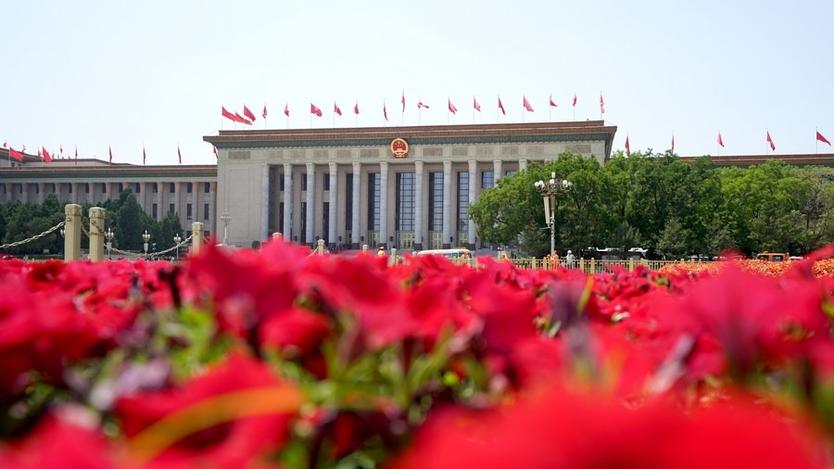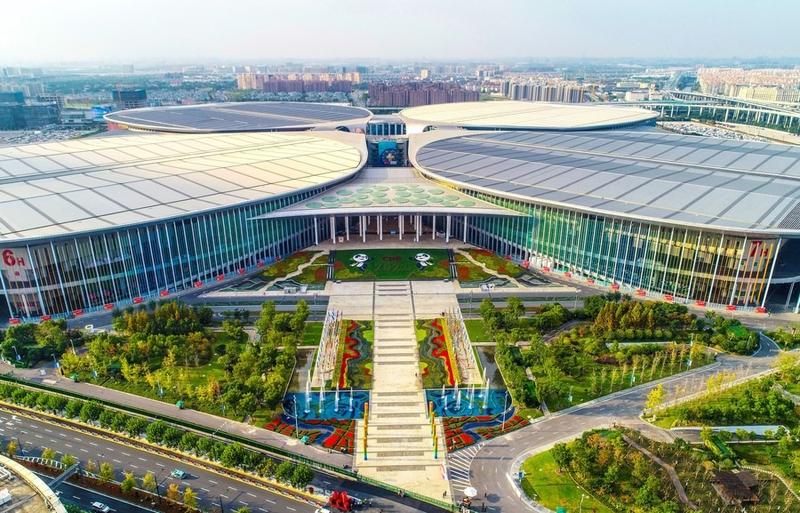 File photo shows a view of the Great Hall of the People in Beijing, capital of China. (PHOTO / XINHUA)
File photo shows a view of the Great Hall of the People in Beijing, capital of China. (PHOTO / XINHUA)
BEIJING - The annual sessions of China's top legislature and political advisory body will open this week to chart the course for a key year in the country's new journey toward national rejuvenation.
The fifth session of the 13th National People's Congress is scheduled to open on Saturday, a day after the opening of the fifth session of the 13th National Committee of the Chinese People's Political Consultative Conference.
The following are some of the topics expected to be high on the agenda of the "two sessions."
Economic goals
At the "two sessions" each year, the annual economic development goals of the world's second-largest economy are among the most-watched topics.
The development goals for 2022 will be unveiled on Saturday in the government work report, which usually includes the country's targets on gross domestic product growth, inflation, the ratio of deficit to GDP, employment, consumption and foreign trade, among others.
Last year, China's economy saw a strong rebound despite sporadic epidemic resurgences and a complicated external environment, with its GDP expanding 8.1 percent year-on-year to 114.37 trillion yuan (about 18 trillion US dollars).
 Aerial photo taken on Oct 31, 2021 shows the National Exhibition and Convention Center in east China's Shanghai. (JIANG ZHONGCHENG / XINHUA)
Aerial photo taken on Oct 31, 2021 shows the National Exhibition and Convention Center in east China's Shanghai. (JIANG ZHONGCHENG / XINHUA)
The government work report is also expected to outline key tasks for this year in areas including the promotion of high-quality development, advancing higher-level opening-up, boosting rural vitalization, and improving people's wellbeing.
The country's fiscal and monetary policies will also be prominent on the agenda, as major global organizations have downgraded forecasts for this year's global growth and warned of rising inflation risks.
Law on local legislatures, governments
As the highest state organ of power, the NPC exercises various functions and powers, including enacting and amending laws.
The upcoming legislative assembly will see lawmakers review a draft amendment to the Organic Law of the Local People's Congresses and Local People's Governments.
Adopted in 1979, the law will go through its sixth amendment, in which a people-centered philosophy of development and whole-process people's democracy are highlighted.
READ MORE: Top political advisory body prepares for annual session
Electoral rules for 14th NPC
According to a suggested agenda unveiled in December, Chinese lawmakers at the NPC session will deliberate a draft decision on the number of deputies to the 14th NPC and their election.
The electoral rules are likely to stipulate the number of lawmakers in the next-term legislature, and the proportion of ethnic, grassroots, military and female lawmakers.
The NPC session will also review two draft methods for the Hong Kong Special Administrative Region and the Macao SAR to elect their deputies to the 14th NPC.
 Visitors take photos of exhibits at the first BEYOND International Technology Innovation Expo in south China's Macao, Dec 2, 2021. (CHEONG KAM KA / XINHUA)
Visitors take photos of exhibits at the first BEYOND International Technology Innovation Expo in south China's Macao, Dec 2, 2021. (CHEONG KAM KA / XINHUA)
Sci-tech innovation
National legislators and political advisors, especially those from the sci-tech sectors, are expected to discuss ways to reinforce China's strength in the sci-tech field and its innovation capability, which will contribute to the country's high-quality development.
In 2021, the total R&D investment in China reached 2.79 trillion yuan, up 14.2 percent year-on-year, according to the Ministry of Science and Technology.
Meanwhile, China's overall innovation capacity ranking rose to 12th in the world, making a good start to the 14th Five-Year Plan (2021-2025).
Liu Feixiang, a national lawmaker and chairman of China Railway Construction Heavy Industry Co, Ltd, said the company will unswervingly promote self-reliance in innovation and further increase R&D investment to tackle technological challenges.
 Flocks of migratory birds forage in the wetland of the Wuxing white crane conservation area by the Poyang Lake in Nanchang, east China's Jiangxi province, Dec 21, 2020. (WAN XIANG / XINHUA)
Flocks of migratory birds forage in the wetland of the Wuxing white crane conservation area by the Poyang Lake in Nanchang, east China's Jiangxi province, Dec 21, 2020. (WAN XIANG / XINHUA)
Green pursuit
The relations between development and emission reductions will continue to be properly handled, as China is on course to fulfilling its carbon peaking and neutrality goals.
According to the country's plan, before 2030, China's carbon emissions will peak, and before 2060, China will achieve carbon neutrality.
While bringing down carbon emissions, efforts will be made to safeguard energy security, industrial and supply-chain security, and food security, as well as to ensure people's normal daily lives.
The proportion of the Chinese economy taken up by the green and low-carbon sector will also be increased, as high-quality growth gains momentum through expanding the high-tech sector and promoting the digital and smart transformation of industry, among other factors.
Tax, fee cuts
China will take more precise and sustainable measures to cut fees and taxes this year to support market entities so as to improve the business environment.
On the basis of 7.6 trillion yuan of tax and fee cuts over the 13th Five-Year Plan period (2016-2020), China cut another 1 trillion yuan in taxes and fees in 2021, which helped mitigate the impact of COVID-19 on market entities.
At a press conference earlier this year, Xu Hongcai, vice-minister of finance, said that China will continue to implement 11 preferential tax and fee policies this year, including those for science and technology, employment and business startups, medical care and education.
"This year, we will also focus on coordinating tax and fee cuts with other fiscal, monetary and industrial policies," Xu added.
Hu Jianwen, an NPC deputy and president of Linwu Shunhua Duck Industrial Development Co, Ltd, a leading food company based in central China's Hunan province, said that companies have benefited greatly from the tax and fee cuts, which effectively reduced costs, increased cash flow and enhanced their confidence in future development.


